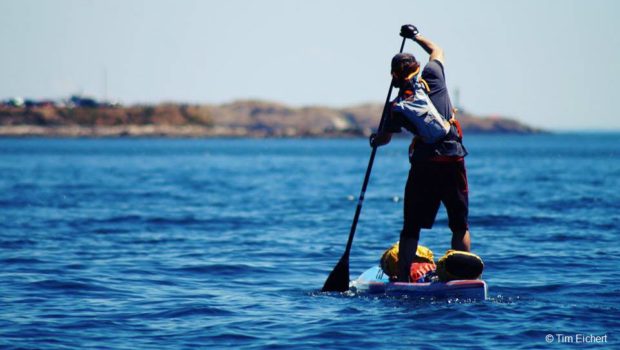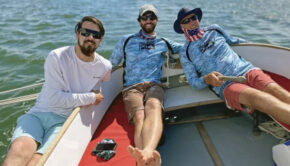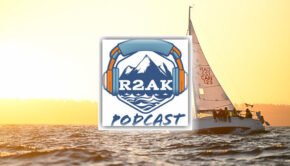R2AK: The Success of Failure
Published on June 29th, 2016
The Race to Alaska (R2K) is a unique 750-mile marathon open to all forms of non-motorized craft. Entrants can have no support of any type; it’s like the Iditarod but on a boat. Avoid drowning, freighters, killer whales, and grizzly bears, and the winner gets $10,000. A set of steak knives awaits the runner-up.
It is a two stage event, with the first stage from Port Townsend, WA to Victoria BC as a 40 mile qualifier before entrants can start the 710 stage from Victoria BC to Ketchikan, AK on June 26. Here’s the update from day three on stage two…
In the weeks before the R2AK’s 2016 model rolled off the showroom floor, our heads were filled with questions on how it would play out.
Would the weather rage for a second year and break masts and sailors, or would human power triumph and evolve with such epic proportions that the Year of the Rowboat be added as the 13th year in the Chinese calendar? Would the trimaran fleet reign supreme, snagging both of the race’s top honors and force Ian Farrier to send us a card, flowers, and a minority position in his company as a way of saying thanks?
What would happen?
As the sun sets on the third day of R2AK, it turns out that we were mostly wrong—ok, totally wrong. Nothing new, being wrong is a bit like comfort food around here, but given last year’s race of gales and this year’s drifter, it’s uncanny how much the two races are identical, at least if you squint and tilt your head.
The multihull in front hit Bella Bella while a monohull was still south of Cape Caution’s big right turn, with more multihulls farther back but gaining all the while. New year, less wind, more boats, but same deal. Weird.
Out in front, Team MAD Dog Racing continues to erase the miles between themselves and Ketchikan in double digit speeds. Behind them two hulls on separate boats have split up around Calvert Island to play out different strategies, each are being pursued by their own trimaran—the Farrier vanguard of Mail Order Bride, and Big Broderna who seem to be closing with every minute. It’s uncanny how similar it all seems. Honestly, it’s kind of freaking us out.
With the big red M32 cat lapping up the miles and light winds and low seas in the forecast, their arrival in Ketchikan is likely only a day or two away. Wow. Their story of speed and sleepless tenacity will be incredible to hear, but while they grind out the last few hundred miles, we’ll take this moment to shift back past the back of the pack to the teams who are going home.
Joining the ranks of the departed in the past 24 hours are Team Why Not, the paddle-boarding grit of Team Heart of Gold, and just this morning Team Bad Kitty has assessed that the damage to their rudder is too extensive to continue.
These glorious failures run the spectrum of the R2AK profile: local guys looking to do something incredible, favorites for the win, and favorites in our hearts for being intrepid and hardcore. Hard to know what’s in their hearts as they increase the total to 11 teams who have exited the race, but it probably feels a bit like failure. Even with the support of fans and family, it has to sting a little.
In the age of self-esteem parenting where everyone gets a ribbon, failure is not something we talk about often. We turn shelves into shrines to heap on the symbols of our successes. We frame the certificates, we never wear our failures on our sleeves, never bring them up in job interviews, or when we’re trying to snag a date with that hottie who is way out of our league. Failure is something we avoid as often as we rebrand it to simultaneously soften the blow and dilute its meaning. Challenge, teachable moment, pivot point, beta version.
Failure is a concept that holds that same strain of loaded discomfort as talking to someone about their terminal illness. It’s uncomfortable and smacks of taboo. Say it right now, “I failed.” Shrink inward a little bit, don’t you? Your voice trails off and eyes glance away to avoid the gaze of even your computer screen.
Even in this fiction failure, it’s as loaded as it is deeply engrained, despite the reality that the only way to never fail is to never try or to make your attempts so snug in their banality that they don’t matter. Pulling up aces with a loaded deck might gain you the chips on the table but isn’t winning. Not really.
Here at R2AK Race Central, we celebrate those who try and triumph; it’s no small thing to prepare and train and then struggle to the other end. With equal voice we try to celebrate the failures on the course because they are evidence of all out ambition we hoped this race would inspire.
A hard fought failure might not be evidence that you had the best theory, but it is the only time when you look yourself in the eye and know that you gave it your all, left everything you had on the field. Failure of that sort of intrepid exhaustion is an effort worthy of celebration.
We celebrate failure at the R2AK because other than $10,000 for one, and a fancy set of steak knives for another, the R2AK is really about the challenge—and for a challenge to be real failure, it has to be a possibility.
While we don’t have a lot of the story on Bad Kitty or Heart of Gold’s attempt, the R2AK betrayed a soul who was more in for the challenge than any chance at winning. “A paddle board? Really?” seemed to be the pro-forma response whenever someone learned about his bid. Those words were followed closely with some combination of “He’s nuts!” and/or “Aren’t you worried about him?” He might be and we were, but less so once we met him.
Team Heart of Gold’s Karl Kruger wasn’t a guy with a board and a paddle and a delusional dream; he had planned and trained for a year—more than that, he had done the math. Lots of math. From calculating weight to knowing how far and how fast he could travel in every condition, to exactly how many calories he could subsist on and how he would get them.
Three thousand calories a day, through dehydrated food pellets he would gnaw on. At 35 calories apiece and 20 minutes to chew through he could just make his goal. Karl’s theory of exacting simplicity (eat pellets, paddle) was working, and by day three his solo performance was ahead of even some trimarans.
The flaw came from a board whose behavior changed with the increased load and exacerbated the vulnerability of his weaker side. When he called it off he was paddling four times more on his left side than he was on his right, and the ratio was getting worse. Time to catch the bus.
Karl’s bid for the R2AK was a heroic one, and his bold but sincere humility inspired—from the internet masses to the crowd on a passing ferry who crowded the deck to cheer his name. Thanks for trying Karl, thanks for stepping into the ring, blowing our minds, and reminding us the richness that is possible when you stop simply avoiding the possibility of failure.
Fail well, fail boldly, fail safe, grow.
Event details – Facebook – Twitter – Stage 1 tracker – Stage 2 tracker
Source: Race to Alaska;, June 28, 2016
Background:
Stage 1: Port Townsend, WA to Victoria BC (40 miles)
It all begins June 23 with an initial race across open water, two sets of shipping lanes, and an international border. The first stage is designed as a qualifier for the full race and as a stand-alone 40 mile sprint for people who just want to put their toe in. Racers continuing on will clear Canadian customs in Victoria. Stage one winners get to bask in the glory for a full day and a half.
Stage 2: Victoria BC to Ketchikan, AK (710 miles)
There’s no time splits from the qualifier that roll over when the fleet starts in Victoria on June 26. The race for the prizes – real or imagined – is getting to Ketchikan. For those that lag, they risk getting tapped out by the sweep boat which heads north along the course as a rolling disqualifier. Any competitor the sweep boat passes is out of the race. Other than two waypoints at Seymour Narrows and Bella Bella, there is no official course. To quote the bard: You can go your own way.
Winner: The 2015 race was won by Team Elsie Piddock – Al Hughes, Graeme Esarey, and Matt Steverson – that crushed the fleet in a F-25c, completing Stage 2 in 5 days, 1 hour, 55 minutes. They finished almost 40 hours ahead of the second place finisher Team MOB Mentality (F85SR, a 28′ Farrier “Super Racer”) which just edged by 4 minutes third place finisher Team Por Favor (Hobie 33).







 We’ll keep your information safe.
We’ll keep your information safe.